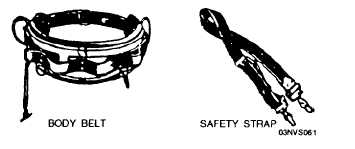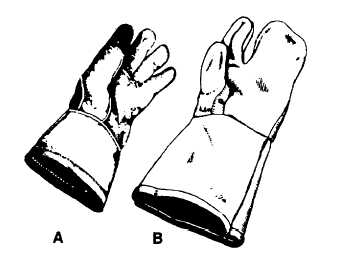Appropriate use of goggles will limit eye hazards.
Some goggles have plastic lenses that resist shattering
upon impact. Others are designed to limit harmful
infrared and ultraviolet radiation from arcs or flames
by use of appropriate filter lenses.
Remember, eye damage can be excruciatingly
painful. PROTECT YOUR EYES.
GLOVES
Use gloves whenever you are required to handle
rough, scaly, or splintery objects. Special flameproof
gloves are designed for gas and electric-arc welding to
limit danger and damage from sparks and other hot
flying objects (fig. 1-60). Personnel in the electrical
fields are usually required to wear insulating rubber
gloves.
Be sure to follow all regulations prescribed for the
use of gloves.
Gloves must not be worn around
rotating machinery unless sharp or rough material is
being handled. If such is the case, EXTREME CARE
SHOULD BE EXERCISED to prevent the gloves
from being caught in the machinery.
SAFETY BELTS AND STRAPS
The safety strap and body belt shown in figure
1-61 are what might be called your extra hands when
you work aloft. The body belt, strapped around your
waist, contains various pockets for small tools. The
safety strap is a leather or neoprene-impregnated
nylon belt with a tongue-type buckle at each end.
While you are climbing you will have the safety strap
Figure 1-60.-Gas and etectric-arc welding gloves.
Figure 1-61.-Safety equipment.
hanging by both ends from the left ring (called a
D-ring because of its shape) on the body belt. When
you are at working position, you unsnap one end of
the safety strap, pass it around the supporting structure
so there is no danger of its slipping (at least 18 inches
from the top of the part on which it is fastened), and
hook it to the right D-ring on the body belt.
The safety strap must be placed around a part of
the structure that is of sufficient strength to sustain an
ABs weight and his or her equipment, and must rest
flat against the surface without twists or turns. It
must not be placed around any part of a structure that
is being removed.
ABs climbing poles at shore
stations must be sure to place the straps beneath arms
and braces of the poles, wherever possible.
Before placing your weight on the strap,
determine VISUALLY that the snap and D-ring are
properly engaged.
Do not rely on the click of the
snap-tongue as an indication that the fastening is
secure.
The body belt and safety strap require inspection
before use. Look for loose or broken rivets; cracks,
cuts, nicks, tears or wear in leather; broken or
otherwise defective buckles, such as enlarged
tongue-holes, defects in safety-belt snap hooks and
body belt D-rings. If you discover any of these or
other defects, turn in your equipment and replace it.
Perform maintenance periodically according to
applicable procedures.
Remember that leather and
nylon belts are treated in different manners.
POWER TOOLS
Power tools have become so commonplace in the
Navy that all ratings now use them in the performance
of maintenance at one time or another.
1-36





